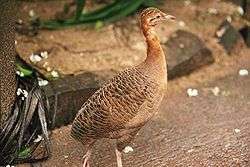Nothurinae
Nothurinae or aridland tinamous[2] is one of two subfamilies of the Tinamidae family, the other being Tinaminae. It contains eighteen species in six genera. The six genera are:
- Rhynchotus (2 species)
- Nothoprocta (6 species)
- Nothura (5 species)
- Taoniscus (monotypic) - dwarf tinamou
- Eudromia (2 species)
- Tinamotis (2 species)
| Nothuriunae | |
|---|---|
 | |
| Rhynchotus rufescens | |
| Scientific classification | |
| Kingdom: | Animalia |
| Phylum: | Chordata |
| Class: | Aves |
| Order: | Tinamiformes |
| Family: | Tinamidae |
| Subfamily: | Nothurinae |
| Genera | |
| Synonyms[1] | |
| |
Description
These birds, as a member of the tinamou, are ground birds that prefer to run and walk, but will fly when needed.[3]
Taxonomy
They are related to the ratites (emus, ostriches, kiwis, and rheas), and are placed with them in the Paleognathae. All of these birds evolved from ancient birds that did fly and tinamous are believed to be a still living primitive family closely related to these ancient birds.[3]
Range and habitat
The members of this subfamily live in South America and prefer hills and arid grasslands and scrublands as opposed to the Tinaminae, which prefer forests.[2]
Footnotes
- Haaramo, Mikko (2007). "Tinamiformes - tinamous". Mikko's Phylogeny Archive. Retrieved 30 December 2015.
- Brown, Joseph W. (2005)
- Davies, S. J. J. F. (2003)
gollark: From that.
gollark: In 32 million μs.
gollark: You have 32 million microseconds.
gollark: I *will* do this, if you don't stop procrastinating in one way or another.
gollark: Anyway, do you want me to explain EVERY SINGLE PART of the OIR™ architecture diagram.
References
- Brown, Joseph W. (2005). "Tinamiformes, Tinamidae, tinamous". Tree of Life Web Project. Retrieved 16 Jul 2009.
- Davies, S. J. J. F. (2003). "Tinamous (Tinamidae)". In Hutchins, Michael; Jackson, Jerome A.; Bock, Walter J.; Olendorf, Donna (eds.). Grzimek's Animal Life Encyclopedia. 8 Birds I Tinamous and Ratites to Hoatzins. Joseph E. Trumpey, Chief Scientific Illustrator (2nd ed.). Farmington Hills, MI: Gale Group. pp. 57–67. ISBN 0-7876-5784-0.
This article is issued from Wikipedia. The text is licensed under Creative Commons - Attribution - Sharealike. Additional terms may apply for the media files.